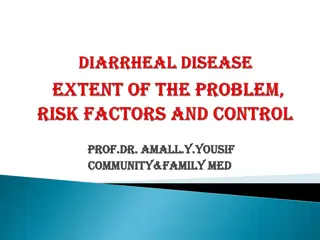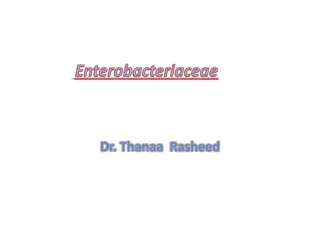Understanding Shigella: Characteristics, Tests, and Diseases
Exploring the characteristics of Shigella bacteria through differential media, biochemical tests, and antigen identification. Learn about the diseases associated with Shigella infections, including the transmission methods and high-risk groups. Discover how Shigatoxin plays a role in Shigella-related illnesses.
Download Presentation

Please find below an Image/Link to download the presentation.
The content on the website is provided AS IS for your information and personal use only. It may not be sold, licensed, or shared on other websites without obtaining consent from the author. Download presentation by click this link. If you encounter any issues during the download, it is possible that the publisher has removed the file from their server.
E N D
Presentation Transcript
MacConkey Agar metalic green on ( EMB ) Differential Media: left: no lactose fermentation right: lactose fermentation
Shigella spp. on HE (blue - green)
Biochemical test (TSI) test : Alk slant (-) ve* Acid butt (+) ve No gas production , no H2S produced . IMVC : v + - - Urease : (-) ve Nitrate reduction : (+) ve
Shigella O antigen Ornithin decarboxylase Lactose S.dysentariae A - - S.flexneri B -- - S.boydii C - - S.sonnei D + - Late+
Shigella C.jejuni Salmonella E.coli V.cholerae G.lamblia E.histolytica C.parvum 10-100 102-106 105 108 108 10-100 cysts 10-100 cysts 1-1000 cysts
Shigella-Diseases Bloody diarrhae containing mucus, Shigatoxin-an exotoxin B unit binds to host cell glycolipids and A cleaves the 28S rRNA , preventing the protein synthesis Shigatoxin can mediate the damage to the glomeru ar endothelial calls, resulting in renal failure (HUS).
Shigella-Epidemiology Humans are only reservoir for these bacteria Disease spread person to person by fecal-oral route Patients at highest risk for disease are young children in daycare centers, nurseries, male homosexuals Relatively few organisms can produce disease (highly infectious) Disease occurs worldwide with no seasonal incidence
Shigella-Treatment, Prevention, and Control Antibiotic therapy shortens the course of symptomatic disease and fecal shedding Treatment should be guided by in vitro susceptibility tests Empiric therapy can be initiated with a fluoroquinolone or trimethoprim-sulfamethoxazole Appropriate infection control measures should be instituted to prevent spread of the organism
Thank you Thank you























